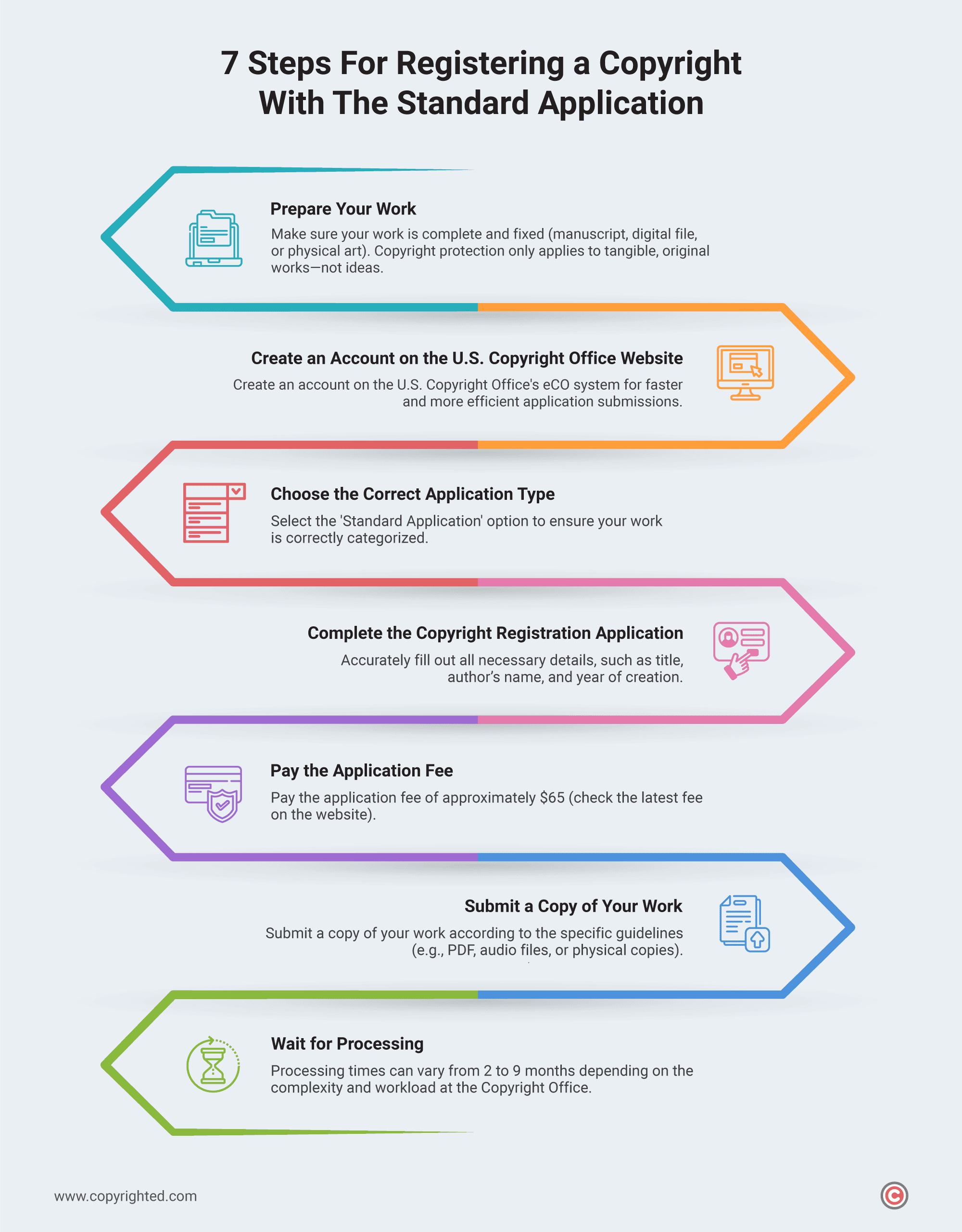As a creator, protecting your work—whether it’s music, writing, or art—is likely a priority. The Copyright Act offers a way to claim ownership, preventing others from using or copying your creations without permission.
One way to formalize this protection is by registering your work with the U.S. Copyright Office using a copyright application.
There are two primary types of copyright applications: the Single Application and the Standard Application.
In this guide, we’ll break down the Standard Copyright Application, covering its key features, the types of works it covers, and how to file it.
- The Standard Copyright Application is ideal for works with multiple authors or complex ownership structures, offering comprehensive protection for various creative outputs.
- This application is suitable for the registration of various types of works, including literary, visual arts, sound recordings, audiovisual works, and works made for hire.
- The filing process involves preparing your work, creating an account on the U.S. Copyright Office website, completing the application, paying a $65 fee, and submitting a copy of the work for review.
Table of Contents
What is a Standard Copyright Application?
The Standard Copyright Application is the most common and comprehensive of the two primary types of copyright applications.
It is typically used for works involving multiple authors and a more complex ownership structure, ensuring that all contributors are protected by copyright.
This type of application is suitable for a wide range of creative works, including but not limited to literary works, visual arts, sound recordings, and motion pictures.
To get a good grasp of what is a standard copyright application, let’s discuss in detail its key features:
- Multiple Authors and Claimants: The Standard Application is designed to accommodate works with more than one author or claimant. This is particularly important for collaborative projects, where each contributor may have specific rights to the work.
- Various Types of Works: Unlike the Single Application, which is limited to certain types of works and specific conditions, the Standard Application covers a broad spectrum of creative outputs. This includes complex creations like audiovisual works, collections of works, and works made for hire.
- Flexible Filing Options: The Standard Application provides more flexibility regarding filing options. For example, it allows for the registration of multiple works in a single application if they meet the criteria for a collection.
- Detailed Ownership Information: The application requires detailed information about the ownership of the work. This includes the names and roles of all authors and any transfer of rights or licenses associated with the work.
The Standard Application provides a more comprehensive registration process, accommodating various types of works and situations.
Understanding the different categories of copyright registration can also help clarify whether the Standard Application is right for your specific type of work, especially when multiple contributors or formats are involved.
In contrast, the Single Application is more streamlined and intended for works with a single author. It is generally simpler and less expensive but is limited to specific scenarios.
To determine which copyright application suits you best, consider the nature of your work. If you’ve written a novel with illustrations by another artist or produced an album with multiple band members, the Standard Application is likely the right choice.
This application covers works with multiple authors or complex elements, ensuring that all contributors and details are protected.
On the other hand, if you’re an independent artist who has created a single painting and is the sole author, the Single Application might be sufficient. This option is simpler and less expensive, making it suitable for straightforward scenarios.
While the Standard Application provides comprehensive protection, it comes with some limitations. The process can be more involved and time-consuming than the Single Application, generally costing more and often requiring more detailed information about your work and its authors.
Carefully assess your specific needs and the complexity of your work to decide which application will offer the best protection for you.
What Types of Work Can Be Registered Using the Standard Application?
The Standard Copyright Application is designed to accommodate various creative works, making it a versatile option for creators with complex or multi-authored projects, particularly when multiple contributors share authorship.
Unlike the Single Application, which is more restrictive, the Standard Application covers an extensive range of artistic, literary, and intellectual creations.
Below are the main types of work that can be registered using the Standard Application.
Literary Works
This category includes written works such as books, manuscripts, essays, articles, poetry, and even certain types of digital content like blogs and e-books. If your work is primarily textual and involves one or more authors, the Standard Application is suitable for securing copyright protection.
Visual Arts
Visual arts encompass a broad spectrum of creative works, including paintings, drawings, sculptures, photographs, graphic designs, and architectural plans. Whether the work is a single piece or part of a larger collection, it can be registered under the Standard Application.
Sound Recordings
Musical compositions or any musical work, spoken word recordings, podcasts, and other types of audio content fall under this category. The Standard Application is ideal for works that involve multiple contributors, such as songwriters, musicians, and producers.
Motion Pictures and Audiovisual Works
This includes feature films, short films, documentaries, video content, and multimedia projects. Because these works often involve numerous contributors like directors, writers, and editors, the Standard Application is the preferred method for registering their copyrights.
Performing Arts
The performing arts category includes dance choreographies, theatrical plays, musical performances, and other live productions. The Standard Application is suitable for registering these works, particularly involving multiple creators or performers.
Computer Programs
Software, applications, and other types of computer programs can be registered using the Standard Application. This category is particularly relevant for works created by development teams, where multiple authors may have contributed to the code.
Collections of Works
Suppose you are registering a collection of related works, such as an anthology of short stories, a series of photographs, or a compilation of songs. In that case, the Standard Application allows you to register them together, simplifying the process and reducing the overall registration cost.
Works Made for Hire
If a work was created as part of an employment agreement or a contract, it is considered a “work made for hire.” The Standard Application is used to register these works, as they often involve complex ownership arrangements between the employer and the creator.
How to Register a Copyright Using the Standard Copyright Application?
Filing a copyright application might sound complicated, but it’s straightforward if you follow the correct steps. Here’s an in-depth guide to help you navigate the process:

Step 1: Prepare Your Work
Ensure that the work you want to register is complete and fixed, like a manuscript, a digital file, or a physical art piece. Copyright protection applies only to tangible, original works that are completed and ready for submission, not ideas or concepts.
Step 2: Create an Account on the U.S. Copyright Office Website
Go to the U.S. Copyright Office’s Electronic Copyright Office (eCO) system. You’ll need to create an account if you don’t already have one. The online registration system enables you to submit applications faster and more efficiently than traditional paper submissions.
Step 3: Choose the Correct Application Type
When filling out your copyright application, make sure to choose the “Standard Application” option. The U.S. Copyright Office offers different forms depending on the type of work registered, so selecting the right one is important for proper registration.
Step 4: Complete the Copyright Registration Application
Provide all necessary details about your work, including the title, the author’s name, and the year of creation. Be thorough and accurate, as mistakes could lead to delays or even rejections of your application.
Step 5: Pay the Application Fee
The current filing fee for a standard copyright application is approximately $65 (as of 2023) if filed online. Fees can vary slightly, so checking the most recent fee schedule on the website is essential.
Step 6: Submit a Copy of Your Work
You must submit a copy of your work as part of the application process. You can submit digital copies such as PDFs and audio files for some works, while others may require physical copies like sculptures and artworks.
Always remember to follow the specific submission guidelines for your type of work.
Step 7: Wait for Processing
After submitting your application, the Copyright Office will review it, and the time it takes to process your application can vary. Still, typically, it ranges from 2 to 9 months, depending on the complexity of your work and the current workload of the Copyright Office.
Once the Copyright Office completes its review, you’ll receive a confirmation of registration. If you’re wondering, “How do I know if my copyright was approved?” the office will typically notify you via email and provide access to your official registration certificate through your online account.
Frequently Asked Questions
What happens after you submit your standard copyright application?
After submission, the U.S. Copyright Office will review your application for completeness and accuracy. If approved, you’ll receive a registration certificate. If there are issues, they may request additional information.
Can you make corrections to a standard copyright application after filing it?
Yes, you can make corrections by submitting a “Supplementary Registration” to amend errors or omissions in your original application.
Can you withdraw or cancel a standard copyright application after submission?
You cannot withdraw or cancel a copyright application once it is submitted. However, you may contact the U.S. Copyright Office for guidance if it’s still under review.
How long does it take to process a standard copyright application?
Processing typically takes 2 to 9 months, but it can vary depending on the workload of the U.S. Copyright Office.
What is the cost of filing a standard copyright application?
As of 2023, the filing fee for a standard copyright application is currently $65.


